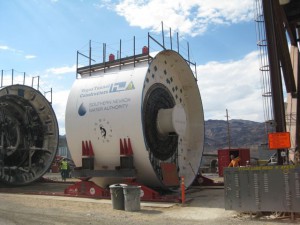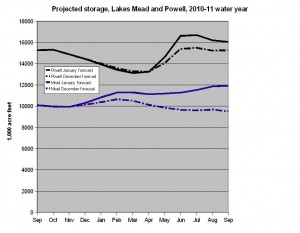udpate: full column here (sub/ad req)
When I first began seriously trying to sort out New Mexico’s place in the scheme of Colorado River water management, I kept banging unsuccessfully up against what seemed like a simple question: If long term drought or permanent climate change reduces the river’s flow, how would the shortage be sorted out? Who, in other words, would have to use less water?
I take a crack at an answer in tomorrow’s newspaper (I’ll add a link when it’s up, in the meantime here’s a blog post teaser), via a new analysis by Doug Kenney at the University of Colorado (pdf of the study here).
As I explain in the column, Kenney makes a straightforward argument: that to the extent climate change or long term drought reduce total flows in the Colorado, the four upper basin states are responsible for reducing their use. California, Arizona and Nevada might have problems of their own (they’re overusing what Colorado River water they get as it is now), but they would not face a climate change-induced cut.
The framers of the Colorado River Compact, it has long been known, made a fundamental mistake in assuming that the Colorado River would reliably supply 16.5 million acre feet of water per year, and dividing it up accordingly – 7.5 million acre feet for the upper basin states, 7.5 million for the lower basin states and the rest for Mexico (actually that “rest for Mexico bit” came later, but it’s part and parcel of the underlying idea of a stationary supply).
Turns out there’s less.

Southern Nevada Water Authority Tunnel Boring Machine, being used to excavate a new, more reliable Lake Mead water intake for Las Vegas water supply as Colorado River levels decline
In the 11 years since 2000, the Colorado has averaged just 12 million acre feet per year, according to the U.S. Bureau of Reclamation. In a sensible world, the shortage would be divided equally among the parties – say, in round numbers. 5.5 maf for the lower basin, 5.5 maf for the upper basin, and 1 maf for Mexico.
But the compact was not written that way. In addition to the 7.5-7.5 split, the Compact has this to say about the upper basin’s water management obligations:
The States of the Upper Division will not cause the flow of the river at Lee Ferry to be depleted below an aggregate of 75,000,000 acre-feet for any period of ten consecutive years reckoned in continuing progressive series beginning with the first day of October next succeeding the ratification of this compact.
As I explain in tomorrow’s column, that “will not cause … to be depleted” line is the sort of thing clever water lawyers will salivate over, sufficiently rich with ambiguity that legal hijinks are sure to ensue. But the risk is that the court will agree with Kenney’s interpretation (and that of most legal scholars) – that the upper basin must deliver 7.5 maf a year no matter what.
That changes the arithmetic. Even if one assumes a reduced share for Mexico, in a 12 maf per year world, you get:
- Mexico – 1 maf
- Lower basin – 7.5 maf
- Upper basin – 3.5 maf
As Kenney puts it:
[T]he Upper Basin apportionment is essentially the last priority on the river, and as average flow volumes decline, this apportionment bears the full brunt of the “squeeze” of reduced water availability.
Some additional links:
- The Colorado River Compact (from the USBR’s great Law of the River web page)
- The 12 maf average for 2000-11 comes from the USBR’s draft Annual Operating Plan for the 2010-11 water year (pdf)
- Kenney’s report (pdf), which is a must-read for anyone interested in the institutional issues surrounding the problems we face on a river that is already over-subscribed, even before climate change



